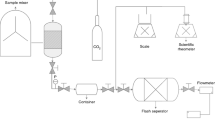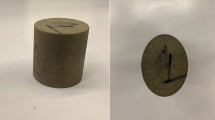Abstract
CO2 has strong abilities of oil swelling and viscosity reduction for heavy oil extraction, N2 is a preferable gas media for pressure maintenance, and their mixture is then considered as an alternative method for enhanced oil recovery (EOR) in a pressure-depleted heavy oil reservoir. PVT analysis and cyclic gas injection experiments are conducted to reveal EOR mechanisms for CO2/N2 mixture, and five different CO2/N2 molar ratios (1:0 (pure CO2), 4:1, 7:3, 1:1, and 0:1 (pure N2)) are designed in this paper. PVT analysis shows that the changes of oil properties including saturation pressure, volume factor, and viscosity are highly related to CO2/N2 ratio of the mixture, and a higher CO2/N2 ratio can always lead to better gas/oil interactions. When CO2/N2 ratio is higher than 7:3, the viscosity can reduce to less than 60% of the initial oil viscosity. Gas injection experimental results show that 4:1 mixture can achieve an oil recovery of 17.31%, which is close to the recovery obtained by pure CO2. For the pressure-depleted oil reservoir, simultaneous CO2/N2 injection or N2 followed by CO2 injection is suitable injection mode for the mixture. With such a design of CO2/N2 mixture, an optimized EOR effect can be achieved with gas/oil interactions dominated by CO2 coupled with energy supplement provided by N2. A pilot test of CO2/N2 mixture injection is successfully conducted in a test well, and an oil increment of 337 t is obtained after 40,000 m3 of N2 injection followed by 80,000 m3 of CO2 injection.












Similar content being viewed by others
References
Agartan E, Gaddipati M, Yip Y et al (2018) CO2 storage in depleted oil and gas fields in the gulf of Mexico. Int J Greenhouse Gas Control 72:38–48
Ahadi A, Torabi F (2018) Effect of light hydrocarbon solvents on the performance of CO2-based cyclic solvent injection (CSI) in heavy oil systems. J Pet Sci Eng 163:526–537
Bossie-Codreanu D, Gallo Y (2004) A simulation method for the rapid screening of potential depleted oil reservoirs for CO2 sequestration. Energy 29:1347–1359
Farías M, Ayala H, Watson R (2009) Experimental and zero-dimensional analysis of CO2-N2 gas cyclic injection processes. Pet Sci Technol 27(2):1360–1379
Guo K, Li H, Yu Z (2016) In-situ heavy and extra-heavy oil recovery: a review. Fuel 185:886–902
Habibi A, Mahmood R, Dehghanpour H et al (2017) Experimental investigation of CO2-oil interactions in tight rocks: a Montney case study. Fuel 203:853–867
Haddad A, Gates I (2017) CO2-based heavy oil recovery processes for post-CHOPS reservoirs. J CO2 Util 19:238–246
Hascakir B (2018) Introduction to thermal enhanced oil recovery (EOR) special issue. J Pet Sci Eng 171:1292–1293
Hemmati-Sarapardeh A, Ayatollahi S, Ghazanfari M et al (2014) Experimental determination of interfacial tension and miscibility of the CO2-crude oil system; temperature, pressure, and composition effects. J Chem Eng Data 59:61–69
Hu H., Whtson C., Qi Y. (1991) A study of recovery mechanisms in a nitrogen diffusion experiment. Society of Petroleum Engineers
Hudgins D, Llave F, Chung F (1990) Nitrogen miscible displacement of light crude oil: a laboratory study. SPE Reserv Eng 5(1):100–106
Ivory J, Chang J, Coates R et al (2010) Investigation of cyclic solvent injection process for heavy oil recovery. J Can Pet Technol 49(9):22–33
Jia B, Tsau J, Barati R (2018) Role of molecular diffusion in heterogeneous, naturally fractured shale reservoirs during CO2 huff-n-puff. J Pet Sci Eng 164:31–42
Jia B, Tsau J, Barati R (2019) A review of the current process of CO2 injection EOR and carbon storage shale oil reservoirs. Fuel 236:404–427
Jiang T, Zeng F, Jia X et al (2014) A new solvent-based enhanced heavy oil recovery method: cyclic production with continuous solvent injection. Fuel 115:426–433
Li B, Xu T, Zhang G et al (2018) An experimental study on gas production from fracture-filled hydrate by CO2 and CO2/N2 replacement. Energy Convers Manag 165:738–747
Liu J, Yan Y, Xu J et al (2016) Replacement micro-mechanism of CH4 hydrate by N2/CO2 mixture revealed by ab initio studies. Comput Mater Sci 123:106–110
Miller J., Jones R. (1981) A laboratory study to determine physical characteristics of heavy oil after CO2 saturation. In: SPE/DOE Enhanced Oil Recovery Symposium, Tulsa, Oklahoma
Mokrys I., Bulter R. (1993) In-situ upgrading of heavy oils and bitumen by propane deasphalting: the vapex process. In: SPE Production Operations Symposium, Oklahoma City, Oklahoma
Sadooni M, Zonnouri A (2015) The effect of nitrogen injection on production improvement in an Iranian rich gas condensate reservoir. Pet Sci Technol 33:422–429
Seomoon H, Lee M, Sung W (2016) Analysis of methane recovery through CO2-N2 mixed gas injection considering gas diffusion phenomenon in coal seam. Energy Explor Exploit 34(5):661–675
Seyyedsar S, Sohrabi M (2017) Visualization observation of formation of a new oil phase during immiscible dense CO2 injection in porous media. J Mol Liq 241:199–210
Shang Q, Xia S, Cui G et al (2017) Measurement and correlation of the interfacial tension for paraffin + CO2 and (CO2 + N2) mixture gas at elevated temperatures and pressures. Fluid Phase Equilib 439:18–23
Shayegi S. (1997) Evaluation of alternative gases for immiscible cyclic injection. PhD Thesis, Louisiana State University, Baton Rouge, LA
Shi L, Liu P, Shen D et al (2019) Improving heavy oil recovery using a top-driving, CO2-assisted flooding method in deep and pressure-depleted reservoirs. J Pet Sci Eng 173:922–931
Shokri A, Babadagli T (2017) Feasibility assessment of heavy-oil recovery by CO2 injection after cold production with sands: lab-to-field scale modeling considering nonequilibrium foamy oil behavior. Appl Energy 205:615–625
Srivastava R, Huang S, Dong S (2000) Laboratory investigation of Weyburn CO2 miscible flooding. J Can Pet Technol 39(2):41–51
Wang X, Gu Y (2011) Oil recovery and permeability reduction of a tight sandstone reservoir in immiscible and miscible CO2 flooding process. Ind Eng Chem Res 50(4):2388–2399
Wang P, Zhao F, Hou J et al (2018) Comparative analysis of CO2, N2, and gas mixture injection on asphaltene deposition pressure in reservoir conditions. Energies 11(9):1–15
Yoosook H, Maneeintr K, Boonpramote T (2017) CO2 utilization for enhance oil recovery with huff-n-puff process in depleting heterogeneous reservoir. Energy Procedia 141:184–188
Yuan D, Hou J, Song Z et al (2015) Residual oil distribution characteristic of fractured-cavity carbonate reservoir after water flooding and enhanced oil recovery by N2 flooding of fractured-cavity carbonate reservoir. J Pet Sci Eng 129:15–22
Zanganeh P, Ayatollahi S, Alamdari A et al (2012) Asphaltene deposition during CO2 injection and pressure depletion: a visual study. Energy Fuel 26:1412–1419
Zhao F., Su W., Hou J., et al. (2018) Experimental study on feasibility and mechanisms of N2/CO2 huff-n-puff in the fractured-cavity reservoir. 11 (21), 660
Acknowledgments
The authors want to acknowledge all the involved colleagues of China University of Petroleum (Beijing), and Drilling & Production Technology Research Institute, PetroChina Jidong Oilfield Company.
Funding
The project is supported by China National Major Technology Project (2017ZX05009-004).
Author information
Authors and Affiliations
Corresponding author
Additional information
Responsible Editor: Santanu Banerjee
Rights and permissions
About this article
Cite this article
Hao, H., Hou, J., Zhao, F. et al. Laboratory investigation of cyclic gas injection using CO2/N2 mixture to enhance heavy oil recovery in a pressure-depleted reservoir. Arab J Geosci 13, 140 (2020). https://doi.org/10.1007/s12517-020-5131-4
Received:
Accepted:
Published:
DOI: https://doi.org/10.1007/s12517-020-5131-4




